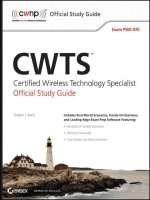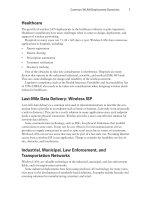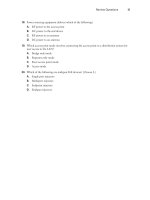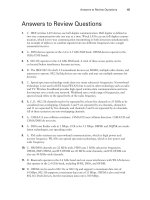cwts certified wireless technology specialist official study guide exam pw0 070 phần 5 potx
Bạn đang xem bản rút gọn của tài liệu. Xem và tải ngay bản đầy đủ của tài liệu tại đây (1003.35 KB, 50 trang )
Answers to Review Questions
157
Answers to Review Questions
1. C. IEEE wireless LAN devices use half-duplex communication. Half duplex is defined as
two-way communication only one way at a time. Wired LANs can use full-duplex commu-
nication, which is two-way communication transmitting in both directions simultaneously.
An example of diplex is to combine signals from two different frequencies into a single
transmitter/receiver.
2. A. DSSS devices operate in the 2.4 to 2.5 GHz ISM band. OFDM devices operate in the
5GHz UNII bands.
3. B. 802.11b operates in the 2.4 GHz ISM band. A total of three access points can be
co-located before interference becomes an issue.
4. D. The IEEE 802.11n draft 2.0 amendment devices use MIMO, multiple radio chains, and
antennas to operate. 802.11a/b/g devices use one radio and may use multiple antennas for
diversity.
5. C. Spread spectrum technology sends data over many subcarrier frequencies. Narrowband
technology is not used in IEEE-based WLANs but is used in other technology such as radio
and TV. Wireless broadband provides high-speed wireless data communications and wire-
less internet over a wide area network. Wideband uses a wide range of frequencies, and
spectral mask refers to the signal levels of the radio frequency.
6. B, C, D. 802.11b channels need to be separated by at least five channels or 25 MHz to be
considered non-overlapping. Channels 3 and 9 are separated by six channels, channels 6
and 11 are separated by five channels, and channels 2 and 8 are separated by six channels.
All of these scenarios are non-overlapping channels.
7. A. CSMA/CA uses collision avoidance. CSMA/CD uses collision detection. CSMA/CR and
CSMA/DSSS do not exist.
8. A. DSSS uses Barker code at 1 Mbps. CCK is for 5.5 Mbps. DBPSK and DQPSK are modu-
lation technologies, not spreading codes.
9. A.
FM radio stations use narrowband communication, which is high power and
narrow frequency. WLANs use spread spectrum technology, which is low power and
wide frequency.
10. C. HR/DSSS channels are 22 MHz wide. FHSS uses 1 MHz subcarrier frequencies.
OFDM, ERP-OFDM, and HT-OFDM use 20 MHz–wide channels, and HT-OFDM can
also use 40 MHz–wide channels.
11. D. Bluetooth operates in the 2.4 GHz band and can cause interference with WLAN devices
that operate in the 2.4 GHz band, including FHSS, DSSS, and OFDM.
12. D. OFDM can be used in 802.11a or 802.11g and supports a maximum data rate of
54 Mbps. 802.11b supports a maximum data rate of 11 Mbps. OFDM is also used with
802.11n Draft devices, but the maximum data rate is 300 Mbps.
38893c05.indd 157 5/19/09 6:05:03 AM
158
Chapter 5
N
Access Methods, Architectures, and Spread Spectrum Technology
13. C. HT-OFDM can support data rates as high as 300 Mbps, OFDM supports a maximum
of 54 Mbps, and DSSS supports a maximum of 11 Mbps. Ethernet is not a wireless LAN
technology.
14. C, D. IEEE 802.11a wireless LANs operate in the 5 GHz UNII bands. 802.11b/g wireless
LANs operate in the 2.4 GHz ISM band.
15. D. IEEE 802.11b and 802.11g amendments are interoperable. 802.11a networks operate in
the 5 GHz UNII bands and therefore are incompatible with 802.11b/g.
16. D. 802.11b operates in the 2.4 GHz ISM band and will allow for 14 channels. The channels
that can be used will depend on where the wireless LAN is located.
17. A. FHSS uses 1 MHz subcarrier frequencies to transfer data. 20 MHz–wide, 22 MHz–
wide, and 40 MHz–wide channels are used with other technologies.
18. B. The IEEE 802.11b amendment specifies data rate of 5.5 and 11 Mbps. OFDM allows for
data rates up to 54 Mbps and is used in IEEE 802.11a and IEEE 802.11g amendments.
19. C. FHSS constantly changes frequencies while transmitting data in a WLAN. DSSS,
OFDM, and MIMO use set channels and frequencies to transmit data.
20. D. Current MIMO technology allows for up to 300 Mbps. One way this is accomplished is
by using multipath as a benefit rather than a hindrance.
38893c05.indd 158 5/19/09 6:05:03 AM
Chapter
6
WLAN Antennas and
Accessories
THE FOLLOWING CWTS EXAM OBJECTIVES
ARE COVERED IN THIS CHAPTER:
Identify RF signal characteristics and the applications of
basic RF antenna concepts
Passive gain
Beamwidths
Simple diversity
Polarization
Identify the purpose, features, and functions of and the
appropriate installation or configuration steps for the fol-
lowing types of antennas
Omnidirectional/dipole
Semidirectional
Highly directional
Identify the use of the following WLAN accessories and
explain how to select and install them for optimal perfor-
mance and regulatory domain compliance
RF cables
RF connectors
Lightning arrestors and grounding rods
Describe the proper locations and methods for installing
RF antennas
Pole/mast mount
Ceiling mount
Wall mount
38893c06.indd 159 5/18/09 4:07:28 PM
Antennas are an essential part of a successful wireless LAN
deployment. From the transmitter perspective, an antenna
will take the energy from the transmission system, transform
it into radio waves, and propagate it through the free air. From the receiver perspective, an
antenna performs the opposite task—it receives the radio waves, transforms them back to
AC signals, and finally sends the information to a computer or other device.
Many factors are involved in determining the proper antenna to be used in an applica-
tion or deployment of a wireless LAN. These factors include:
Indoor or outdoor installation
Distance between transmitter and receiver
Frequency to be used
Horizontal or vertical polarization
Aesthetics
Cost
Manufacturer
Intended use
Mounting brackets
Electrical characteristics
Height
Location
Local ordinances
Basic RF Antenna Concepts
It is important to understand some of the basic theory, characteristics, and terminology
associated with antennas prior to learning how they operate. Becoming familiar with this
will help in making decisions when it comes to sales and support of antennas and wireless
LAN systems. Some of the terminology for characteristics of antennas is listed here:
RF lobes—Shape of the RF patterns
Beamwidth—Horizontal and vertical measurement angles
38893c06.indd 160 5/18/09 4:07:29 PM
Basic RF Antenna Concepts
161
Antenna charts—Azimuth and elevation
Gain—Changing the RF coverage pattern
Polarization—Horizontal or vertical
RF Lobes
The term lobe has many meanings depending on the context in which it is used. Typically
it is used to define the projecting part of an object. In anatomical terms, an example would
be part of the human ear known as the ear lobe. In botanical terms, a lobe is the divided
part of a leaf. As a radio frequency technology term, lobe refers to the shape of the RF
energy emitted from an antenna element. RF lobes are determined by the physical design
of the antenna. Antenna design also determines how the lobes project from an antenna
element.
The effect of antenna design and the shape of the RF lobes are two reasons why choos-
ing the correct antenna is a critical part of a wireless LAN design. Antennas may project
many lobes of RF signal, some of which are not intended to be usable areas of coverage. The
type of antenna utilized—omnidirectional, semidirectional, or highly directional parabolic
dish—will determine the usable lobes. These antennas as well as the RF radiation patterns
they project will be discussed in more detail later in this chapter. Figure 6.1 shows an example
of RF lobes emitted from an antenna element.
FIGURE 6.1 RF lobes’ shape and coverage area are affected by type of antenna.
Highly directional parabolic dish antenna
Main signalSide lobes
Beamwidth
The design of an antenna will determine how RF propagates and the specific patterns in
which it propagates from an antenna element. As mentioned earlier, the patterns of energy
emitted from an antenna are known as lobes. For antennas, the beamwidth is the angle of
measurement of the main RF lobe measured at the half-power point or –3 dB point. Beam-
width is measured both horizontally and vertically, in degrees.
38893c06.indd 161 5/18/09 4:07:29 PM
162
Chapter 6
WLAN Antennas and Accessories
Azimuth and elevation charts available from the antenna manufacturer will show the
beamwidth angles.
The azimuth refers to the horizontal RF coverage pattern, and the elevation is the vertical
RF coverage pattern. The azimuth is the view from above or the “bird’s-eye view” of the RF
pattern; in some cases it will be 360°. Think of the elevation as a side view. If you were to
look at a mountain from the side view, it would have a certain height or elevation measured in
feet or meters. For example, Pikes Peak, a mountain in the front range of the Rocky Moun-
tains, has an elevation of 14,115 feet (4,302 meters). Figure 6.2 shows a representation of
horizontal and vertical beamwidths.
FIGURE 6.2 Horizontal (azimuth) and vertical (elevation) beamwidths measured at the
half power point
Vertical
beamwidth
Horizontal
beamwidth
Reading Azimuth and Elevation Charts
Understanding how to read an azimuth and elevation chart is good to know from a techni-
cal sales, design, or integration perspective. Knowing these patterns will help when making
hardware recommendations for customers based upon needed coverage and device use.
These charts show the angles of RF propagation from both the azimuth (horizontal or
looking down) and the elevation (vertical or side view). These charts give a general idea
of the shape of the RF propagation lobe based on antenna design.
38893c06.indd 162 5/18/09 4:07:30 PM
Basic RF Antenna Concepts
163
Antenna manufacturers test antenna designs in a laboratory. Using the correct instru-
ments, an engineer is able to create the azimuth and elevation charts. These charts show
only approximate coverage area based on the readings taken during laboratory testing
and do not take into consideration any environmental conditions such as obstacles or
interference. The following image shows an example of an azimuth and elevation chart.
90°
120°
150°
180°
210°
240°
270°
300°
330°
0°1020 3
30°
60°
90°
120°
150°
180°
210°
240°
270°
300°
330°
0°1020 3
30°
60°
Vertical Horizontal
Im age provIded by www.L-com.com.
Understanding how to read one of these charts is not very complicated. Notice the chart
is a circular pattern with readings from 0° to 360°, and there are many rings within these
charts. The outermost ring shows the strongest signal from the testing process of this
antenna. The inner rings show measurements and dB ratings less than the strongest
measured signal from the outside ring. A good-quality chart will show the most accurate
readings from the testing process. A sales or technical support professional can use
these charts to get an idea of how the radiation pattern would look based on a specific
antenna type and model.
Antenna Gain
The gain of an antenna provides a change in coverage that is a result of the antenna focusing
the area of RF propagation. This gain is produced from the physical design of the antenna ele-
ment. In Chapter 4, “Radio Frequency (RF) Fundamentals for Wireless LAN Technology,” we
looked at various characteristics of radio frequency. One of these characteristics is amplitude,
which was defined as the height (voltage level) of a sine wave. The amplitude is created by
varying voltage over a period of time and is measured at the peaks of the signal from top
to bottom. Amplification of an RF signal will result in gain. An antenna is a device that
38893c06.indd 163 5/18/09 4:07:31 PM
164
Chapter 6
WLAN Antennas and Accessories
can change the coverage area, therefore propagating an RF signal further. Antenna gain is
measured in decibels isotropic (dBi), which is a change in power as a result of increasing the
isotropic energy. Isotropic energy is defined as energy emitted equally in all directions. The
sun is a good example of isotropic energy, emitting energy in a spherical fashion equally
in all directions. Figure 6.3 shows an example of energy being emitted from an isotropic
radiator.
FIGURE 6.3 A perfect isotropic radiator emits energy equally in all directions.
Passive Gain
It’s actually quite intriguing how an antenna can provide passive gain, a change in coverage
without the use of an external power source. Because of how antennas are designed, they
focus isotropic energy into a specific radiation pattern. Focusing this energy increases cov-
erage in a particular direction. A common example used to describe passive gain is a mag-
nifying glass. If a person is standing outside on a beautiful sunny day, the sun’s energy is
not very intense because it is being diffused across the entire earth’s hemisphere. Therefore,
there is not enough concentrated energy to cause any harm or damage in a short period of
time. However, if this person was to take a magnifying glass and point one side of the mag-
nifying glass toward the sun and the other side toward a piece of paper, more than likely
the paper would start to heat very quickly. This is because the convex shape of the magnify-
ing glass focuses or concentrates the sun’s energy into one specific area, therefore increasing
the heat to that area.
Antennas are designed to function in the same way by focusing the energy they receive
from a signal source into a specific RF radiation pattern. Depending on the design of the
antenna element, as the gain of an antenna increases, both the horizontal and vertical
radiation patterns will also increase. Figure 6.4 shows a drawing of a wireless LAN system
with 100 mW of power at the antenna. Because of passive gain, the antenna emits 200 mW
of power.
38893c06.indd 164 5/18/09 4:07:31 PM
Basic RF Antenna Concepts
165
FIGURE 6.4 Access point supplying 100 mW of power and an antenna with a gain of
3 dBi for an output at the antenna of 200 mW
Access point
Antenna gain
of 3 dBi
Power at antenna
100 mW
Antenna power out
200 mW
Exercise 6.1 is a simple way to demonstrate passive gain.
EXERCISE 6.1
Demonstrate Passive Gain
You can demonstrate passive gain by using a standard 8.5” × 11.0” piece of notebook
paper or cardstock.
1. Roll a piece of paper into a cone or funnel shape.
2. Speak at your normal volume and notice the sound of your voice as it propagates
through the air.
3. Hold the cone-shaped paper in front of your mouth.
4. Speak at the same volume.
5. Notice that the sound of your voice is louder. This occurs because the sound is now
focused into a specific area or radiation pattern, hence passive gain occurs.
Active Gain
Active gain will also provide an increase in signal strength. Active gain is accomplished by
providing an external power source to a device in the wireless LAN system. An example
of such a device is an amplifier. An amplifier is placed in series in the wireless LAN system
and will increase the signal strength based on the gain of the amplifier.
If an amplifier is used in a wireless LAN system, certain regulatory domains require that
the amplifier must be certified as part of the system. It is best to carefully consider whether
an amplifier is necessary before using such a device in an IEEE 802.11 wireless LAN sys-
tem. Using an amplifier may nullify the system’s certification and potentially exceed the
allowed RF limit.
38893c06.indd 165 5/18/09 4:07:32 PM
166
Chapter 6
WLAN Antennas and Accessories
Antenna Polarization
Antenna polarization describes how a wave is emitted from an antenna and the orientation
of the electrical component or electric field of the waveform. To maximize signal, the trans-
mitting and receiving antennas should be polarized in the same direction or as closely as
possible. Antennas polarized the same way ensure the best possible signal.
If the polarization of the transmitter and receiver are different, the power of the signal
will decrease depending how different the polarization is. Figure 6.5 shows an example of
horizontal and vertical polarized antennas.
FIGURE 6.5 Horizontally and vertically polarized antennas
Horizontally polarized antennas
(vertical beam)
Vertically polarized antennas
(horizontal beam)
With the large number of wireless LAN devices available, it is a challenging task to
accomplish the same polarization for all devices on the network. Performing a wireless
LAN site survey will show signal strength based upon several factors, including polariza-
tion of access point antennas. This survey will help determine the received signal strength
of the wireless LAN devices. Site surveys and antenna polarization will be discussed in
more detail in Chapter 9, “Performing a WLAN Site Survey.”
Antenna Polarization Example/Experiment
It is fairly simple to demonstrate antenna polarization with a notebook computer or other
wireless LAN device and either a wireless network adapter client utility or other third-
party software that shows signal strength and/or signal to noise ratio. One such utility is
InSSIDer, a free open source Wi-Fi network scanner for Windows Vista and Windows XP.
The InSSIDer program is included on the CD that comes with this book. InSSIDer displays
the received signal strength from the access points in the receiver area.
38893c06.indd 166 5/18/09 4:07:32 PM
WLAN Antenna Types
167
You can visualize polarization by performing the following steps. This experiment should
be performed using a notebook computer within close proximity to an access point.
1. Verify that you have a supported wireless network adapter.
2. Install and launch the InSSIDer program or other utility that shows signal strength.
3. Monitor the received signal strength (RSSI) value.
4. While monitoring the RSSI value, change the orientation of the notebook computer.
5. Notice the change in the RSSI value (either an increase or decrease) when the orien-
tation of the computer changes with respect to the access point.
This demonstrates how polarity can affect the received signal of a device.
WLAN Antenna Types
The type of antenna that is best for a particular installation or application will depend on
the desired RF coverage pattern. Making the correct choice is part of a good wireless LAN
design. Using the wrong type of antenna can cause undesirable results, such as interference
to neighboring systems, poor signal strength, or incorrect coverage pattern for your design.
Three common types of antennas for use with wireless LANs are:
Omnidirectional/dipole antennas
Semidirectional antennas
Highly directional antennas
This section describes each type of antenna in more detail and provides specifications
and installation or configuration information about these antennas.
Omnidirectional Antennas
Omnidirectional antennas are very common on most access points of either SOHO or enter-
prise grade. An omnidirectional antenna has a horizontal beamwidth (azimuth) of 360°.
This means that when the antenna is vertically polarized (perpendicular to the earth’s surface)
the horizontal radiation pattern is 360° and will propagate RF energy in every direction hori-
zontally. The vertical beamwidth (elevation) will vary depending on the antenna’s gain. As the
gain of the antenna increases, the horizontal radiation pattern will increase, providing more
horizontal coverage. However, the vertical radiation pattern will decrease, therefore provid-
ing less vertical coverage.
The shape of the radiation pattern from an omnidirectional antenna looks like a donut.
Figure 6.6 shows an example of the radiation pattern of an omnidirectional antenna.
38893c06.indd 167 5/18/09 4:07:32 PM
168
Chapter 6
WLAN Antennas and Accessories
FIGURE 6.6 The omnidirectional radiation pattern has a donut shape.
Omnidirectional antennas are one of the most common type of antennas for indoor
wireless LAN deployments. Most access points use omnidirectional antennas. Access
points come with either fixed or removable antennas. If the antenna is removable, the
installer can replace it with one of different gain. Enterprise-grade access points typically
have removable antennas that are sold separately.
Some regulatory domains require the use of proprietary connectors with respect to
antennas. These connectors limit access points to the specific antennas tested with the sys-
tem. Therefore it is best to consult with the manufacturer of the access point or other wire-
less LAN transmitting device to determine which antennas may be used with the system.
The most common type of omnidirectional antenna used indoors is known as the “rubber
duck antenna.” This type of antenna typically has a low gain of 2 dBi to 3 dBi and con-
nects directly to an access point. Rubber duck antennas usually have a pivot point so the
polarization can be adjusted vertically or horizontally regardless of how the access point
is mounted.
Some antennas function in both the 2.4 GHz ISM band and the 5 GHz UNII band and
can thus work with a multiband device.
Figure 6.7 Shows a rubber duck omnidirectional antenna.
Omnidirectional Antenna Specifications
In addition to the beamwidth and gain, omnidirectional antennas have various other speci-
fications to be considered, including:
Frequency range
Voltage standing wave ratio (VSWR)
Polarization
Cable length
Dimensions
Mounting
Table 6.1 is an example of a specification sheet for a rubber duck omnidirectional antenna.
38893c06.indd 168 5/18/09 4:07:33 PM
WLAN Antenna Types
169
FIGURE 6.7 2.4 GHz Rubber Duck Omnidirectional Antenna
Im age provIded by www.L-com.com.
TABLE 6.1 Omnidirectional Antenna Specifications
Electrical Specifications
Frequency ranges 2400–2500 MHz
Gain 2.2 dBi
Horizontal beamwidth 360°
Impedance 50 ohm
Maximum power 50W
VSWR <2:0
38893c06.indd 169 5/18/09 4:07:33 PM
170
Chapter 6
WLAN Antennas and Accessories
Mechanical Specifications
Weight 52 oz. (25 g)
Length 4.7” (105 mm)
Maximum diameter 0.4” (10 mm)
Finish Matte black
Connector Reverse polarity SMA plug
Operating temperature –40° C to 60° C (–40° F to 140° F)
Polarization Vertical
Flame rating UL 94HB
RoHS-compliant Yes
A physical representation of the antenna is also helpful for sales and integration profes-
sionals. Figure 6.8 shows the physical specifications diagram for a rubber duck omnidirec-
tional antenna.
Azimuth and elevation charts are usually available to allow visualization of the RF radi-
ation pattern emitted from the antenna. This is useful for a wireless LAN professional to
determine the approximate RF propagation pattern. The purpose of these charts as well as
how to read them was explained in “Reading Azimuth and Elevation Charts” earlier in this
chapter. Figure 6.9 shows the charts for a rubber duck omnidirectional antenna.
Semidirectional Antennas
Semidirectional antennas take power from the transmitting system and focus it into a
more specific pattern than an omnidirectional antenna offers. Semidirectional antennas
are available in various types, including patch, panel, sector, and Yagi. These antennas
are manufactured for either indoor or outdoor use and are designed to provide more spe-
cific coverage by focusing the horizontal radiation pattern to a value of less than 360°. A
semidirectional antenna will allow the wireless LAN designer to provide RF coverage to
a specific area within a deployment. This coverage area may consist of rooms or areas in
which an omnidirectional antenna may not be the perfect solution. For indoor installations,
such areas include rectangular rooms or offices, hallways, and long corridors. For outdoor
deployments, they include point-to-point and point-to-multipoint bridging installations.
TABLE 6.1 Omnidirectional Antenna Specifications (continued)
38893c06.indd 170 5/18/09 4:07:33 PM
WLAN Antenna Types
171
FIGURE 6.8 Rubber duck omnidirectional antenna physical specifications
0.4˝
(10mm)
4.7˝
(105mm)
02.˝
(4mm)
FIGURE 6.9 Vertical (elevation) and horizontal (azimuth) charts for omnidirectional
antenna
90°
120°
150°
180°
210°
240°
270°
300°
330°
0°1020 3
30°
60°
90°
120°
150°
180°
210°
240°
270°
300°
330°
0°1020 3
30°
60°
Vertical Horizontal
Im age provIded by www.L-com.com.
38893c06.indd 171 5/18/09 4:07:34 PM
172
Chapter 6
WLAN Antennas and Accessories
The measurement unit for radio waves is named after Heinrich Rudolf
Hertz (February 22, 1857, to January 1, 1894). He was a German physicist
and the first to satisfactorily show the existence of electromagnetic waves.
Patch/Panel Antennas
In the wireless LAN world, the terms patch and panel are commonly used to describe the
same type of antenna. The intended use will affect the choice of patch/panel antenna to
be used in a specific application. Choosing the correct patch/panel antenna will require
knowing the dimensions of the physical area to be covered as well as the amount of gain
required. A patch/panel antenna can have a horizontal beamwidth of as high as 180°, but
usually the horizontal beamwith is between 50° and 80°. Figure 6.10 shows a 2.4 GHz flat
patch antenna.
FIGURE 6.10 2.4 GHz 8 dBi flat patch antenna
Im age provIded by www.L-com.com.
38893c06.indd 172 5/18/09 4:07:35 PM
WLAN Antenna Types
173
Appropriate Use of a Semidirectional Antenna
A small business consultant is tasked with providing wireless LAN access to several
offices in a multi-tenant building. The client wants to provide adequate coverage for
the offices they lease but would like to minimize the number of access points. The cli-
ent wishes to use access points and antennas that are aesthetically pleasing since these
offices allow public access. The areas to be covered are rectangular, as shown below.
One solution would be to provide several access points using low-gain omnidirectional
antennas. The following image illustrates how several access points could be used to pro-
vide coverage to this area.
However, the consultant believes that if low-gain rubber duck omnidirectional antennas
are used, an access point with significant output power would be required to cover the
length of the rooms. In addition, the client wants to minimize the number of access points
and make the installation aesthetically pleasing.
38893c06.indd 173 5/18/09 4:07:35 PM
174
Chapter 6
WLAN Antennas and Accessories
An alternate solution is to use a patch antenna on both sides of the office, thereby pro-
viding adequate coverage and minimizing the use of access points. The following image
shows patch antennas mounted at both ends of the office area as well as the projected
coverage area of both antennas.
Patch/Panel Antenna Specifications
The specifications for semidirectional antennas such as patch or panel vary based on
the design of the antenna. Semidirectional antennas are available in single or dual band
capability. Semidirectional antennas may be used indoors or outdoors depending on the
application. Table 6.2 is an example of a specification sheet for a 2.4 GHz 8 dBi flat patch
antenna.
TABLE 6.2 Flat Patch Antenna Specifications
Electrical Specifications
Frequency ranges 2400–2500 MHz
Gain 8 dBi
Horizontal beamwidth 75°
Vertical beamwidth 65°
Impedance 50 ohm
Maximum power 25 W
VSWR <1.5:1 avg
Mechanical Specifications
Weight 0.4 lb. (.18 Kg)
Dimensions 4.5 x 4.5 x 0.9˝ (114 x 114 x 23 mm)
38893c06.indd 174 5/18/09 4:07:36 PM
WLAN Antenna Types
175
Radome material UV-inhibited polymer
Connector 12˝ N-female
Operating temperature –40° C to 85° C (–40° F to 185° F)
Mounting Four ¼˝. (6.3 mm) holes
Polarization Horizontal or vertical
Flame rating UL 94HB
RoHS-compliant Yes
Wind survival >150 mph (241 kph)
WIND LOADING DATA
Wind Speed (mph)
Loading
100 5 lb.
125 7 lb.
Azimuth and elevation charts are also available for patch/panel antennas. Figure 6.11
shows the charts for the 2.4 GHz 8 dBi flat patch antenna.
FIGURE 6.11 Vertical (elevation) and horizontal (azimuth) charts for 2.4 GHz 8 dBi
patch antenna
90°
120°
150°
180°
210°
240°
270°
300°
330°
0°1020 3
30°
60°
90°
120°
150°
180°
210°
240°
270°
300°
330°
0°1020 3
30°
60°
Vertical Horizontal
Im age provIded by www.L-com.com.
TABLE 6.2 Flat Patch Antenna Specifications (continued)
38893c06.indd 175 5/18/09 4:07:36 PM
176
Chapter 6
WLAN Antennas and Accessories
Sector Antennas
Sector antennas can be used to create omnidirectional radiation patterns using semidirec-
tional antennas. These antennas are often used for base station connectivity for point-to-
multipoint connectivity. Sector antennas have an azimuth that varies from 90° to 180°.
These are typically configured to offer a total azimuth of 360°. For example, using sector
antennas with an azimuth of 120° each would require three antennas in order to get omni-
directional or 360° coverage. This is a common configuration used with cellular phone
technology. Figure 6.12 shows a sector panel antenna.
FIGURE 6.12 2.4 GHz 14 dBi 90° sector panel antenna
Im age provIded by www.L-com.com.
Sector Antenna Specifications
As mentioned earlier, sector antennas are commonly configured in an array to allow semi-
directional antennas to provide omnidirectional coverage. This is useful in a campus
environment or community arrangement to provide wireless LAN access such as Internet
access. Table 6.3 is an example of a specification sheet for a 2.4 GHz 14 dBi 90° sector
panel WLAN antenna.
38893c06.indd 176 5/18/09 4:07:37 PM
WLAN Antenna Types
177
TABLE 6.3 90° Sector Panel WLAN Antenna Specifications
Electrical Specifications
Frequency ranges 2400–2500 MHz
Gain 14 dBi
Horizontal beamwidth 90°
Vertical beamwidth 15°
Impedance 50 ohm
Maximum input power 300 W
VSWR <1.5:1 avg
Front to back ratio >23 dB
Lightning protection DC ground
Mechanical Specifications
Weight 4.4 lbs. (2 kg)
Dimensions 20 x 7 x 3.5˝ (500 x 180 x 90 mm)
Radome material UV-inhibited plastic
Connector Integral N-female
Operating temperature –40° C to 85° C (–40° F to 185° F)
Mounting 2² (50 mm) diameter mast maximum
Polarization Vertical
Flame rating UL 94HB
RoHS-compliant Yes
Wind survival >130 mph (210 Km/h)
38893c06.indd 177 5/18/09 4:07:37 PM
178
Chapter 6
WLAN Antennas and Accessories
WIND LOADING DATA
Wind Speed (mph)
Loading
100 32 lb.
125 49 lb.
Figure 6.13 shows the charts for the 2.4 GHz 14 dBi 90° sector antenna.
FIGURE 6.13 Vertical (elevation) and horizontal (azimuth) charts for 2.4 GHz 14 dBi 90°
sector panel antenna
90°
120°
150°
180°
210°
240°
270°
300°
330°
0°1020 3
30°
60°
90°
120°
150°
180°
210°
240°
270°
300°
330°
0°1020 3
30°
60°
Vertical Horizontal
Im age provIded by www.L-com.com.
Yagi Antennas
Yagi antennas are designed to be used indoors in long hallways and corridors, or outdoors
for short-range bridging (typically less than two miles). Yagi antennas have vertical and
horizontal beamwidths ranging from 25° to 65°. The radiation pattern may look like a fun-
nel or a cone. As the signal propagates away from the antenna, the RF coverage naturally
widens (diffusion). The aperture of the receiving antenna is much narrower than the signal
at that point. This is a result of diffusion, which is the biggest form of loss in an RF link.
Figure 6.14 shows a Yagi antenna.
TABLE 6.3 90° Sector Panel WLAN Antenna Specifications (continued)
38893c06.indd 178 5/18/09 4:07:37 PM
WLAN Antenna Types
179
FIGURE 6.14 2.4 GHz 15 dBi Yagi antenna
Im age provIded by www.L-com.com.
Yagi Antenna Specifications
Table 6.4 is an example of a specification sheet for a 2.4 GHz 15 dBi Yagi WLAN antenna.
TABLE 6.4 15 dBi Yagi Antenna Specifications
Electrical Specifications
Frequency ranges 2400–2500 MHz
Gain 14.5 dBi
–3 dB beamwidth 30°
Impedance 50 ohm
Maximum power 50 W
VSWR <1.5:1 avg
Lightning protection DC short
Mechanical Specifications
Weight 1.8 lbs. (.81 kg)
Dimensions – Length × diameter 18.2 x 3˝ (462 x 76 mm)
38893c06.indd 179 5/18/09 4:07:37 PM
180
Chapter 6
WLAN Antennas and Accessories
Mechanical Specifications ( c ontinued )
Radome material UV-inhibited polymer
Connector 12² N-female
Operating temperature –40° C to 85° C (–40° F to 185° F)
Mounting 1-1/4” (32 mm) to 2” (51 mm) diameter
masts
Polarization Vertical and horizontal
Flame rating UL 94HB
RoHS-compliant Yes
Wind survival >150 mph (241 kph)
WIND LOADING DATA
Wind Speed (mph)
Loading
100 12 lb.
125 19 lb.
Figure 6.15 shows the charts for the 2.4 GHz 14 dBi Yagi antenna.
FIGURE 6.15 Vertical (elevation) and horizontal (azimuth) charts for 2.4 GHz 14 dBi
Yagi antenna
90°
120°
150°
180°
210°
240°
270°
300°
330°
0°1020 3
30°
60°
90°
120°
150°
180°
210°
240°
270°
300°
330°
0°1020 3
30°
60°
Vertical Horizontal
Im age provIded by www.L-com.com.
TABLE 6.4 15 dBi Yagi Antenna Specifications (continued)
38893c06.indd 180 5/18/09 4:07:38 PM
WLAN Antenna Types
181
Outdoor Installation of Yagi Antennas
A Yagi antenna may be in a weatherproof enclosure. This is not required, but may be use-
ful in outdoor installations. The weatherproof enclosure will prevent collection of certain
elements such as snow and ice. Radome covers are available for parabolic dish antennas
for the same purpose.
Highly Directional Antennas
Highly directional antennas are typically parabolic dish antennas used for long-range
point-to-point bridging links. These antennas are available with a solid reflector or a grid.
Some manufacturers of parabolic dish antennas advertise ranges of 25 miles or more
depending on the gain and the environmental conditions. Parabolic dish antennas have very
narrow horizontal and vertical beamwidths. This beamwidth can range from 3° to 15° and
has a radiation pattern similar to that of a Yagi with the appearance of a funnel. The beam-
width starts very narrow at the antenna element and naturally widens because of diffusion.
Because these antennas are designed for outdoor use, they will need to be manufactured to
withstand certain environmental conditions including wind rating and appropriate mount-
ing. Figure 6.16 shows a parabolic dish antenna.
FIGURE 6.16 5 GHz 28.5 dBi parabolic dish antenna
Im age provIded by www.L-com.com.
38893c06.indd 181 5/18/09 4:07:39 PM









